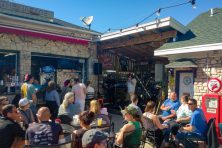The Greenest Building in America, Maybe the World – Here in Wisconsin
- Share
- Tweet
- Pin
- Share
The diminutive, white-haired woman in the front row was one of the honored guests at the U.S. Green Building Council convention in Chicago this past winter. The woman is no stranger to environmental awareness and innovation. Nina Leopold Bradley, a writer and conservationist in her own right, is also the daughter of Aldo Leopold, a founding conservationist and the father of wildlife management. The honor being given was for the green building design of the Aldo Leopold Legacy Center in Wisconsin
The Aldo Leopold Legacy Center was completed earlier in 2007, and is located north of Devils Lake in Sauk County on the Wisconsin River. It was awarded the Platinum LEED Certification from the U.S. Green Building Council for achieving 61 points of 69 possible from the Leadership in Energy and Environmental Design (LEED) rating system. This is the highest LEED score of any building rated so far in the world. Such an achievement was the result of innovative architectural design, engineering, and construction that utilized on-site timber, renewable energy and high efficiency design. The building is a carbon neutral structure, which means there is no net gain in carbon dioxide emissions on an annual basis through its operation. It uses 70 percent less energy than a building that would satisfy local building codes.
Nina Leopold Bradley and her team were presented with the Platinum LEED Certification award by USGBC President Rick Fedrizzi as over 8,000 people looked on from their seats in the McCormick Center in Chicago.
Fedrizzi said, “This building does things that people dream of.”
The designers of the building presented the details in their talk entitled, “The Land Ethic: A Convergence of Ecology, Aesthetics, and Engineering.” Present were Joel Krueger and Tom Kubala with The Kubala Washatko Architects group, Buddy Huffaker with the Aldo Leopold Foundation, and Michael Utzinger, University of Wisconsin-Milwaukee, School of Architecture.
Buddy Huffaker spoke about Aldo Leopold’s vision of the land, and his understanding of the land ethic. He quoted from Leopold’s Sand County Almanac, and said the Leopold Foundation strived to live up to the founder’s legacy and purpose.
“Our goal,” Huffaker said, “was to utilize local materials, and maintain a carbon neutral building.” The team harvested 90,000 board feet of pine. “Trees were thinned from above,” he said. “They needed to be thinned so that there was room to grow. We took the worst trees out and left the best.”
The architectural design of the building took innovation and creativity to optimize its energy use and conservation, and the optimal use of green building materials. Architect Tom Kubala said, “The architectural process was one of letting the land ethic affect our design process.”
Kubala described the rediscovery and use of intuitive observation, and the need for close collaboration, commitment and mindful action within the sphere of environmental awareness that Leopold realized. Kubala said, “Architects come from a background that is abstract, ego-driven, competitive, technology driven and object oriented. We had to unlearn this and become intuitive, ego-less, and practice cooperation within a process driven mode.” He contrasted Leopold’s way with the traditional architect’s way, and described a process of unlearning, realization, and ultimate insight.
Kubala stressed that the designers did not follow a LEED checklist, but wove the design around the Leopold insights. He said using Leopold’s way was “…a completely different way of seeing the world. This project is a model of collaboration: ecology, engineering, energy modeling, architecture, system controls, mechanical and plumbing, structural and electrical engineering, and construction, and so on.”
Professor Michael Utzinger ran the numbers to make it all work. He looked at the energy requirements of the 12,000 square foot building.
“We wanted a carbon neutral design, and asked ourselves what we should do to generate rather than denigrate…Our task was to design a building to fit energy sources, not build a building and then find out what energy we wanted,” he said. In essence the team set a solar budget for the site, and then designed the building to fit that budget.
The result is perhaps one of the greenest buildings in the world. Its zero-carbon footprint, architecturally innovative and beautiful design, and high-science components mark the Aldo Leopold Legacy Center as an example of what is needed in America’s buildings. Many of the innovations and tried-and-true applications can be used in residential and commercial structures at competitive costs when well thought out designs are considered.
Nina Leopold Bradley quoted her father in her “Living in a World of Wounds” commentary: “A thing is right when it preserves the integrity, stability, and beauty of the community.” In his philosophy, it is right when an act “strengthens and re-knits the web of relationships, and so tends to preserve the integrity, stability and beauty of the community.”
And the Leopold Legacy Center building is true to Nina Leopold Bradley’s father’s vision.
A Few of the Details
• The cost to build was around $300 per square foot, about $4 million total
• $300,000 was spent for the photovoltaic system: 3,000 square feet of photovoltaic panels translates to about 50,000 kilowatt hours per year
• Lights go off when the sun is up
• HVAC is off when weather is mild
• There is thermal zoning in the building using natural ventilation, wood stove, heat pump on ground loop
• All offices and occupied spaces have natural ventilation; incoming fresh air goes through in-ground large pipes (Earth Tubes)
• Displacement ventilation occurs from low velocity fans at the floor, which pick up heat that rises
• In-slab radiant heating and cooling
• 16 wells at 220 feet deep are used for water, including water heat pump on ground loop
• 500-gallon storage tanks hold hot water (105 – 115؛ F) during heating and cold water (45 – 55؛ F) during cooling
• Metal roof installed to reduce maintenance
For more information: http://www.aldoleopold.org


